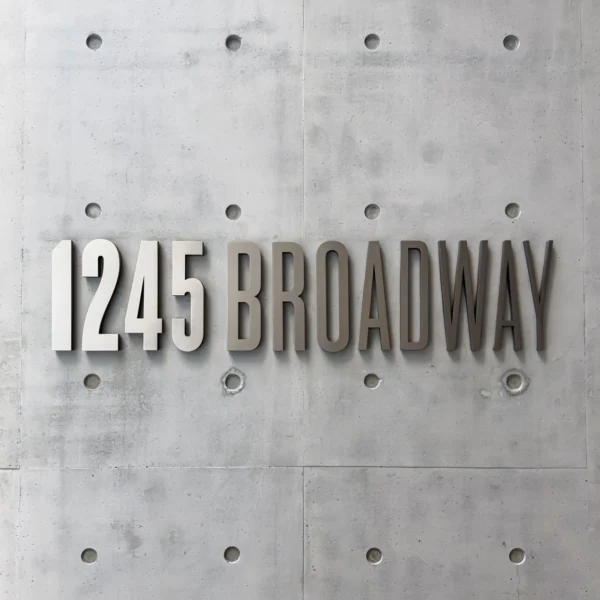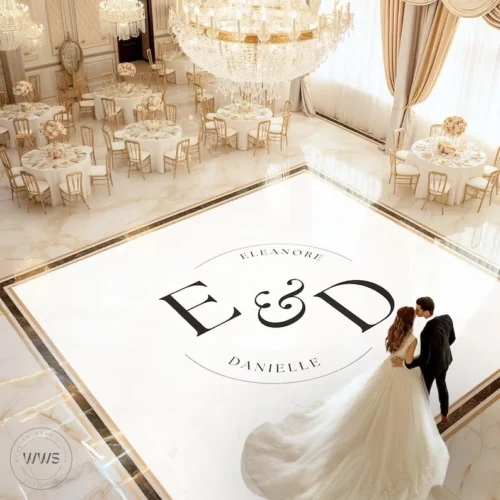Custom Architectural Signage
Architectural signage refers to custom signs that are specifically designed to be an integral part of a building’s environment, enhancing both its functionality and aesthetic appeal. These signs go beyond simple wayfinding or branding to incorporate elements that are cohesive with the building’s architecture and design ethos. Architectural signage is a broad term that encompasses various types of signs used within and outside buildings.
Characteristics of Architectural Signage
- Integration with Design: Architectural signs are crafted to harmonize with the architectural features and overall design scheme of the surroundings. This integration can involve using similar materials, styles, and colors as those used in the building’s construction.
- Materials: These signs are often made from high-quality materials such as brushed aluminum, stainless steel, bronze, glass, and high-grade plastics. The choice of materials is usually influenced by the need for durability, aesthetic consistency, and the architectural elements of the building.
- Functionality: While architectural signage must be visually appealing, it also needs to be highly functional. It serves critical purposes like wayfinding, identifying spaces (like offices, rooms, or buildings), providing information, and ensuring compliance with accessibility standards.
- Customization: Each architectural signage project is typically bespoke, designed to meet specific needs and preferences. This customization might include unique shapes, custom graphics, and integrated lighting solutions.
Uses of Architectural Signage
Wayfinding Architectural Signage
These are comprehensive sign systems within complexes like universities, healthcare facilities, corporate campuses, and large public spaces that help guide traffic and offer clear directions to various locations. Wayfinding signage ensures that visitors can navigate complex environments with ease, reducing confusion and improving overall flow.
Identifying Architectural Signage
These include entrance signs, directory signs, and tenant boards that provide identification and directional assistance to visitors and employees. Identifying signage helps people locate specific buildings, offices, or departments quickly, enhancing the efficiency of movement within a facility.
Informational Architectural Signage
This can cover a wide array of needs, from displaying the history of a building to instructions for using facilities within the building. Informational signage provides valuable context and instructions, helping users understand their environment and make informed decisions.
Decorative Purposes Architectural Signage
Architectural signs can also serve a purely aesthetic function, enhancing the visual appeal of a space or building. Decorative signage adds an artistic element to the architecture, contributing to the overall ambiance and aesthetic harmony of the environment.
Advantages of Architectural Signage
Enhanced Navigation
Architectural signage helps in efficiently guiding people through complex environments, improving the user experience. Clear, well-placed signs reduce frustration and ensure that visitors can find their way easily.
Brand Reinforcement
Consistently designed signage reinforces brand identity and creates a cohesive look throughout the property. By incorporating brand colors, logos, and fonts, signage contributes to a unified and professional appearance.
Regulatory Compliance
Ensures that signage meets all necessary legal requirements, including those for accessibility and emergency egress. Compliance with regulations such as the Americans with Disabilities Act (ADA) ensures that all visitors, including those with disabilities, can navigate the space safely and effectively.
Durability and Longevity
Made from high-quality materials, architectural signs are built to withstand environmental factors and the wear and tear of high traffic areas. Durable signage ensures long-term usability and maintains its appearance despite exposure to elements and constant use.
[blocksy-content-block id="10807"]




Reviews
There are no reviews yet.